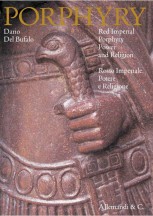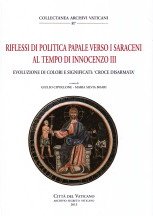Prof. Dario Del Bufalo
Specialist in stone sculpture , colored marbles , glyptics , restoration and Geoarchaeology
Archivio
Home Page
BUFALE ARCHEOLOGICHE dal Giornale dell’Arte February 2016 “Problematic crates”
In July 2015, the Public Prosecutor’s office of the Republic of Geneva (Switzerland) ordered in Italy’s favour for the release of 45 crates containing “archaeological finds of inestimable value”, which had been locked in a vault of the free port of Geneva for over 15 years. The prosecutor of Rome and the Carabinieri for Cultural...
BUFALE ARCHEOLOGICHE in Giornale dell’Arte January 2016 “BETTER NOT TO DIG!”
I went back to visit the so-called Villa of Pliny in Ostia (I-II century AD) and I must say that it is getting worse…a disaster. Firstly, it is closed to visitors, the signs to find one’s way to the site are non-existent, the barriers are destroyed despite the gate is still standing with a dissuasive...
BUFALE ARCHEOLOGICHE in Giornale dell’Arte December 2015 “Rome: a closed city”
Once you could visit the Roman Forum without having to pass through gates or pay an entrance fee, you could freely enter the Colosseum without crossing those hideous Innocenti tubes (placed there provisionally and that then became permanent…like everything in Italy), you could stroll along the Colle Oppio (the Oppian Hill) in the evening or...
BUFALE ARCHEOLOGICHE in Giornale dell’Arte November 2015 “ISIS and ISIAO”
ISIS advances and brutally murders the courageous “Guardian of Palmyra”, 81-year old archaeologist Khaled Asaad, who refused to reveal the hiding place of the artworks in the Antiquarium at Palmyra to the ISIS brutes. Equally atrocious was the killing of the cultural dialogue between East and West that Asaad promoted for years and that was...
BUFALE ARCHEOLOGICHE in Giornale dell’Arte October 2015 “Tut remain in his apartment ”
Egypt: the Minister of Antiquities, Mr Eldamaty, decided a few days ago that Tutankhamun’s mummy (i.e. the real body) will remain in his tomb, the KV62. According to the Ministry, after many technical debates, this decision was taken for conservation reasons and problems. A side chamber in KV62, discovered by Howard Carter in 1922, will...
BUFALE ARCHEOLOGICHE in Giornale dell’Arte April 2015 “Obsessed with integrations”
Obsessed with integrations The restoration of the Parthenon in Athens has been going on for more than ten years with financing and tight surveillance by Unesco and, despite some criticism (always too little) we continue to call them «restorations»: why? We should we call them «maniacal exercises in stone integration» or «works that are too...
BUFALE ARCHEOLOGICHE in Giornale dell’Arte March 2015 “A Roman basin conserved in an Etruscan museum ”
A Roman basin conserved in an Etruscan museum The black and white photo illustrated here depicts the oil tycoon, John Paul Getty (1971) at his residence in La Posta Vecchia at Palo Laziale. He poses proudly for the photographer Milton Gendel near a Egyptian red Porphyry basin (labrum) from the Roman period, which he acquired...
BUFALE ARCHEOLOGICHE in Giornale dell’Arte February 2015 “Sign the restoration”
Sign the restoration The photograph illustrated here is of a 2nd century AD marble Roman sarcophagus conserved in the Archaeological Museum of Albano, a few kilometres from Rome. The curiosity (and at the same time, the horror) is that the «integrative» restoration carried out on the strigil decoration has been documented in a violent and...
UNESCO Restoration at Bassae: ugly and costly
A GdA reader reports a UNESCO fiasco in a place as poetic as Arcadia: Dear Mr Del Bufalo, I fully agree with you about damage done by UNESCO. The fiasco that they are carrying out with the “restoration” work on the Temple of Bassae in Arcadia has left me bewildered. A...
BUFALE ARCHEOLOGICHE in Il Giornale dell’Arte January 2015 “I’m leaving UNESCO”
I’m leaving UNESCO I have seen many ugly and incorrect restorations and integrations around the world. Many under the auspices of UNESCO, with their big brass plaque, such as the reconstruction of the walls of Samarkand using «fake» materials and incorrect drawings or as in the two examples of «integrative» restoration carried out in Turkey...
Remembering Luigi De Cesaris…
Between 2006 and 2008 De Cesaris led the restoration of the tetrarchic frescoes in the Temple of Amun in Luxor supported by USAID, ARCE (American Research Center in Egypt). During the work, Luigi asked my advice concerning the iconography of the images that he was cleaning and unveiling. I would often go and visit De Cesaris at his Egyptian...
Porphyry, Red Imperial Porphyry Power and Religion
This monograph examines the stone material par excellence used throughout the Roman Empire and the most costly of Diocletian’s Edict: Egyptian Red Porphyry. The fortunate circumstances of knowing Professor Raniero Gnoli, who wrote the introduction to this book, and the research and travel carried out with him, have allowed the author to present a large amount of information...
An Egyptian Porphyry bust of Cavour
Rome. An Egyptian Imperial Red Porphyry bust portraying Camillo Benso, Count of Cavour is conserved in the Blue Room in the Palazzo Senatorio on Capitoline Hill. This portrait is circa 82 cm high and depicts a fairly young Cavour, about 45 years old and certainly after 1856, the year in which he received the medal that he wears around...
 English
English Italiano
Italiano














